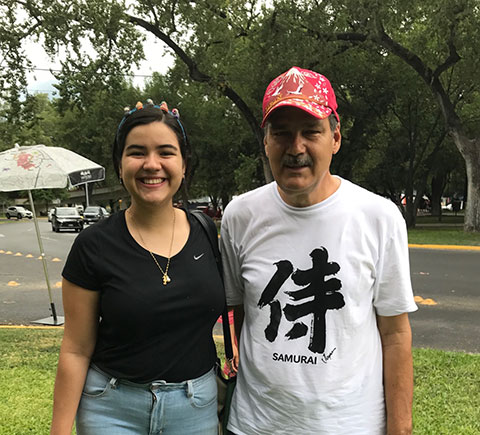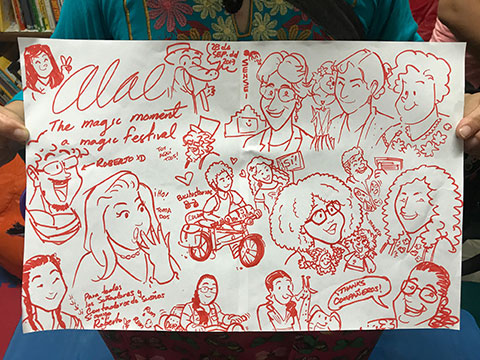
In March of 2017, I was surprised and delighted to receive an invitation from Maria Teresa Farfán Garcia (known to her friends as Tere — top row, second from left) to participate in the "Alal-2017" V International Festival of Kamishibai and Oral Narration in and around the city of Monterrey in Nuevo Leon, Mexico. The word Alal means "baby" in Tseltal, and each year the festival is given a different name, meaning baby in a different indigenous language of Mexico. The festival lasted a whole week from September 22 to 28 and a group of about 20 storytellers of all kinds participated from Central and South America. I was one of six other kamishibai storytellers. Each day of the festival, we were divided up into groups of three or four storytellers (usually with one kamishibai storyteller per set) and sent out to perform in schools, libraries, community centers, and parks in and around the city of Monterrey.
I was amazed to learn that this kamishibai festival is already in its fourth year (it is the 5th because they did two festivals in one of those years) and that there are so many passionate practitioners of kamishibai in this part of the world! And this does not even include other kamishibai practitioners who had taken part in the festival in earlier years. I was particularly fascinated by the variety and inventiveness of their kamishibai performances and how each storyteller has adapted the form to their own unique perspectives, so I asked to interview them all for the Kamishibai for Kids website.
But before introducing the kamishibai storytellers, I want to take a moment to thank Tere and her family and friends who helped to organize this complicated event, especially her friend Grace (far left in the photo above)—a dedicated school librarian and storyteller in her own right—and Tere's husband Jorge (see below), who shuttled us everywhere we needed to go. I especially would like to thank Tere's daughter Etery (also below), who speaks both Japanese and English fluently and spent much of the week I was there serving as my interpreter. My experience of the festival would not have been the same without her!

In the following interviews, readers will meet the director of the festival for the past four years, Maria Teresa Farfán Garcia, who lives in Monterrey with her family and comes to kamishibai with a love of Japanese culture and of sharing stories, especially of peace, in her community. Maria Fé Ibarra Ramirez, Pedagogical Technical Advisor of the Spanish language from the state of Durango in Mexico, has adapted many published stories to the kamishibai format as a method to teach literacy throughout her school district. She also wrote her masters thesis about pedagogical uses of kamishibai. I also interviewed Sakiko Yokoo, a dancer and founder of the nonprofit "Teo tsunagu Mexico to nihon," who was born in Japan but speaks Spanish fluently and also lives in Mexico. Sakiko performed a beautiful kamishibai story she designed for infants, singing Japanese onomatopoeic words as a soundtrack for her soothing and rhythmical watercolors. Marisa Alicia Lanteri, a teacher, social worker, and puppeteer from Argentina, incorporates into her performances her love of poetry and song. Laura Yanes, a teacher of dramatic arts from Honduras, has developed her own unique use of the kamishibai stage and cards, with the cards acting as shifting stage sets for her dolls, which she manipulates in front of and around the stage. Finally, Roberto Mendoza brings to kamishibai his many talents as a graphic artist and dynamic storyteller. Although he did not perform his own kamishibai during the week of Alal, he helped me to perform my kamishibai stories as my interpreter, when Etery was not available. He also managed to capture remarkable caricatures of the whole group on one page on the last day of the festival (see below).

A recurring theme with all of the kamishibai storytellers whom I met at the festival was a particular enthusiasm for the kamishibai stage. In almost all cases, their kamishibai stages had been hand crafted by a family member or friend, and Laura and Marisa, in particular, had each come up with uniquely colorful and dramatic rituals for opening or presenting their stages in the course of their performances.
As more and more people around the world discover the versatility of kamishibai as a format, I look forward to seeing all the new variations and adaptations that will come to light. In the following interviews, we asked all the kamishibai storytellers who attended "2017-Alal" to speak about their involvement with kamishibai in their own words so that readers can learn first-hand about some of the exciting new directions kamishibai is traveling into as it spreads around the globe in the 21st century.
Enjoy!
Tara McGowan, PhD
Author of The Kamishibai Classroom: Engaging Multiple Literaciers through the Art of 'Paper Theater' and Performing Kamishibai: An Emerging New Literacy for a Global Audience.






